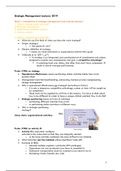Samenvatting
Summary Lectures Strategic Management 2019 UvA
- Instelling
- Universiteit Van Amsterdam (UvA)
- Boek
- Strategic Management
Notes from all the lectures of the course Strategic Management 2019 (part of the minor Business Administration: Managing Strategy and Marketing) with an overview of concepts (glossary) at the end. (Teacher: Marten Stienstra)
[Meer zien]





